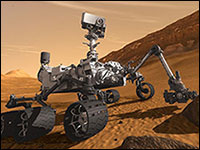
Buoyed by the recent success of its Mars rover Curiosity, NASA on Tuesday announced plans for a multiyear Mars program that includes launching a new robotic science rover in 2020.

Even more significantly, it’s also eyeing the possibility of a manned expedition just a decade later.
“The Obama administration is committed to a robust Mars exploration program,” NASA Administrator Charles Bolden said. “With this next mission, we’re ensuring America remains the world leader in the exploration of the Red Planet, while taking another significant step toward sending humans there in the 2030s.”
A Multifaceted Push
This latest announcement further extends NASA’s Mars focus, which already encompasses numerous efforts:
- the current Curiosity and Opportunity rovers;
- two NASA spacecraft and contributions to one European spacecraft currently orbiting Mars;
- the 2013 launch of the Mars Atmosphere and Volatile EvolutioN (MAVEN) orbiter to study the Martian upper atmosphere;
- the Interior Exploration using Seismic Investigations, Geodesy and Heat Transport (InSight) mission, which will take the first look into the deep interior of Mars; and
- participation in ESA’s 2016 and 2018 ExoMars missions, including providing Electra telecommunication radios to ESA’s 2016 mission, and providing a critical element of the premier astrobiology instrument on the 2018 ExoMars rover.
The new rover planned for 2020 will be based on the Mars Science Laboratory (MSL) architecture that carried the Curiosity rover to the Martian surface this summer. Details regarding its payload and the scientific instruments included will be openly decided, NASA said, beginning with the establishment of a science definition team that will be tasked to outline the mission’s scientific objectives.
‘NASA Needs Visionary Missions’
“The Mars Curiosity rover has justifiably generated huge excitement,” Mario Livio, senior astrophysicist with the Space Telescope Science Institute, told TechNewsWorld. “It combines the romantic appeal of exploration with an attempt to answer one of the most intriguing questions: Is there life elsewhere?”
Still, “undoubtedly many questions will remain unanswered, and Curiosity’s findings are likely to generate new questions,” Livio pointed out. “Consequently, it is crucial to have an imaginative plan that will keep the excitement alive.
“The planned new Mars rover will help pave the way for the ultimate exploration goal — for now — of putting humans on Mars,” he concluded. “NASA absolutely needs visionary missions that will ensure its leading role in both science and exploration.”
A Narrow Focus
At the same time, “while maintaining our Mars exploration program is very important, we are effectively ignoring — or reducing dramatically our pace of investigation for — the rest of the solar system,” said William Newman, a professor in UCLA’s departments of earth and space sciences, physics and astronomy, and mathematics.
“While some would complain about the new Rover’s cost, it is significantly lower than the price tag on a single B-2 stealth bomber — by about 1/3!” Newman pointed out.
“Our return on basic science, as NASA has demonstrated for more than a half century, can never be calculated in advance, yet remains much greater than the original investment,” he told TechNewsWorld.
‘They Could Thrill and Inspire Us’
It’s the possibility of a manned mission that makes the prospect so intriguing, suggested Randa Milliron, CEO and cofounder of Interorbital Systems and Trans Lunar Research.
“The public is no longer interested in robotic missions — they simply are not compelling,” Milliron explained. “Unless people are involved in real exploration on the surface of another world — on what could be a future home for the human race — no one cares. The total focus of NASA should be manned spaceflight.”
Astronauts on such a trip “could carry the experimental equipment that the rovers haul,” she added. “These explorers could make on-the-spot assessments, repairs, determinations about life on that planet… and what is most important of all, they could thrill and inspire us with reports from the scene.
“Without human presence, the endless line of robots to Mars on billion-dollar missions is simply a waste of mankind’s time and resources,” Milliron concluded. “The course of action is obvious: SEND PEOPLE!”
A 7-Month Trip
Of course, the success of a mission like that is entirely dependent on our ability to carry it off, and Paul Czysz, a professor emeritus of aerospace engineering with St. Louis University, isn’t at all sure that’s close within reach.
Whereas the moon is roughly a 48-hour trip away, for example, “with nuclear propulsion, you can get to Mars in seven months,” Czysz told TechNewsWorld. “It’s eight months to get back.”
Because of the Red Planet’s orbit, meanwhile, “Mars is sometimes on the other side of the Sun,” Czysz added. “We have to wait until it gets into a position in which you can get there without frying yourself alive.”
Mars is also very cold, with a maximum summer temperature of zero degrees Celsius, he added, and “there’s no water, no animals and no navigation system.”
‘A Lot of Homework to Do’
Human survival, then, would depend on the ability to generate water as well as an automatic greenhouse sent up ahead of time to grow food, and also the ability to generate rocket fuel for local exploration trips on the planet.
Also critical, of course, would be pressurized living quarters with oxygen and a shield system to protect humans from solar flares and plasma storms, Czysz said.
Multiple cargo vehicles would have to travel to the planet along with the human crew, and any repairs would have to be made by the visiting humans without any help from those on Earth. That’s particularly daunting, given the Red Planet’s orbital pattern.
“You get 44 days on the surface; if you miss your window to leave, you have to wait eight to nine months for the next one,” Czysz explained.
Bottom line: “We have a lot of homework to do before we start talking about going to Mars,” Czysz warned.
With temperatures that dip as low as -40 C to -60 C, “you’d better have some pretty warm underwear,” he quipped.





















































